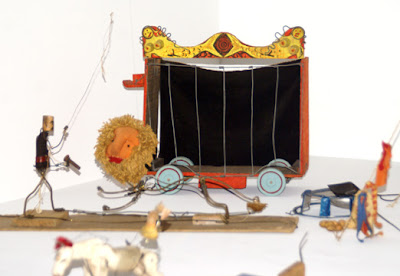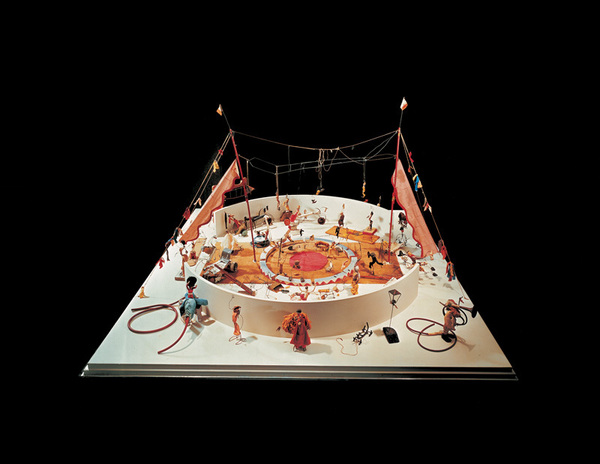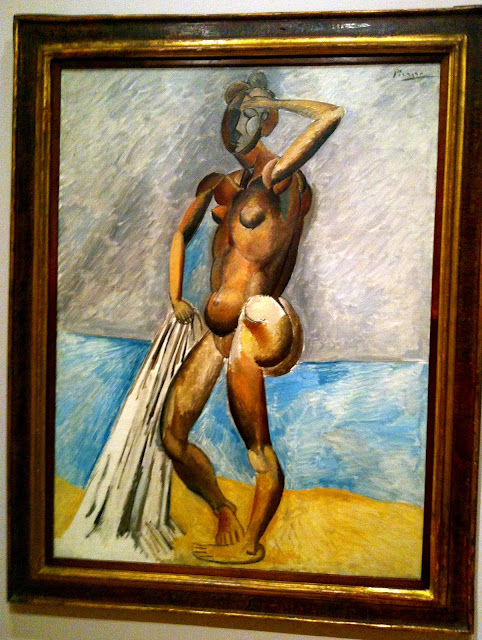Mar 8, 2012 | MoMA, painting
Water lilies, water lilies, water lilies. One of the most renowned and beautiful pieces of art sits before me right now. I mean, I couldn’t not write about it. Or at least try. I don’t know when these paintings arrived at the MoMA, but I’m so glad they’re here. The different layers of water, white, and lillies gives the whole scene so much depth. The rich, whitest pink that reflects the clouds above, along with the dark deep shadows on the right, lets me imagine the world outside this piece, and imagine myself in it. Another layer of depth comes from the varying shades of blue, indicating which spots of the lake are the deepest within the water. The green lillies are surrounded by a light hue of purple in some places, setting them apart while blending them into the blue water beneath at the same time. So so beautiful. Everyone come see it in person. Right this second.
Feb 28, 2012 | installation, sculpture, The Whitney Museum
 |
|
Lion and Cage from Calder’s Circus, 1926-31, from thecityreview.com |
Wire and fancy. That’s how I would describe this piece, or pieces rather. Three huge sets of miniature circus performers made of made of metal, wire, fabric, and yarn. A metal plated kangaroo the size of my hand rolls on ribbed washers. A clown wearing multi-colored layers topped by a lion coat has an almost ironically painted smile of red on his small wooden face. A lion with a plush face, yarn mane, and wire body is being tamed outside his cage by his wire-bodied master. And there’s tight-rope walkers, cowboys, acrobats, sword swallowers, everything expected of a circus setting, even the ringnmaster. I think I like it so much because there’s something about the idea of the circus that lends itself to being portrayed through this fanciful, although unglamorous, medium of wire.
 |
| Calder’s Circus, 1926-31, from the Whitney Museum of Art’s website. |
 |
| Alexander Calder, Roaring with his Circus Lion, 1971, from kaufmann-mercantile.com . |
Feb 15, 2012 | painting, The Met
 |
| Magna on canvas. At the Met. |
The title pretty much says it all with this one. Well, either “On Deck” or “Reminiscent of a 60s Coke Ad.” “On Deck” is probably more poignant, not to mention accurate considering no one in the image is even holding a coke. Instead we see couples having another kind of drink on the deck of a cruise ship. Headscarves and sunglasses are worn by those around a red table holding red drinks. One man on the right stares solitarily into the distance, but everyone else seems to be engaged in general merriment, or at the very least conversation. This was definitely during a time when cruise ships were the exotic luxuries they started off as, and not the smelly, crowded islands of isolation they are now. The colors are incredibly rich– the bright blue sky with thin whisky clouds mirrors the blue clothing of those at the table. The woman closest to us has her bare legs in the sun’s rays as she enjoys a cigarette. The glamorous side of a regular life.
Feb 14, 2012 | MoMA, painting
 |
| Oil on canvas. It’s at the MoMA! |
His body is shown contorted, comprised of rounded shapes derived from the natural world. Reality is not a concern in this place, a semi-composite view is even used to reveal a second butt cheek and a line of back muscle that would have remained hidden otherwise. His face is grayed and abstracted in the same fashion. His joints consist of more rounded pieces than the rest of him; each piece of his shoulder fits into the next the same way our shoulders give us the same ability. But second to his abstracted use of composite parts, comes his use of color, with dark to light gradients revealing shadows on his back and a point of light lying behind the viewer. And the abstract use of stark white on his behind and dull gray on his face complements the rest of the portraits abstract nature. He’s holding his towel that still partly lingers on the ground while wiping his brow with his other hand. His unnatural pose and abstract representation leave us with no indication as to whether he’s just had a bath or is about to. He could be really dirty or really clean, although it hardly seems to matter. Only in that it gives him a reason to be nude and on the beach.
Feb 5, 2012 | painting, The Met
.JPG) |
| Oil on canvas, The Met |
The flow and sparkle of the river spills across the entire canvas. The small naked child in the foreground has her back to us– she’s about to jump in and join her friends whose white and pink gowns are already clinging to their bodies and floating in the water. Even though the little girl’s distinct shape separates her from the dream-like scene, the same melting shades of yellow, green, and blue are reflected in her skin and in the shadows cast on it. The smallest shadow, cast by her left shoulder blade onto her back, gives her a level of naturalism that contrasts with her flowy, dreamy surroundings. Her feet are in transition, inches from the water and already blurrier than the rest of her that is to follow. She wears a red ribbon in her braided brown hair, the sole addition to her soft, glowing body. The only face revealed to us within the scene is faceless. It’s that of the white-gowned older girl, and it only further emphasizes this lake as a dream-scape– elusive and blurry, but sparkling and beautiful. The little girl’s friends led her, and now she’s leading us to the lake.













